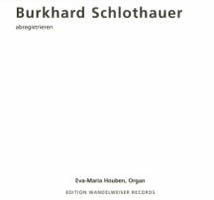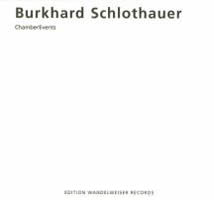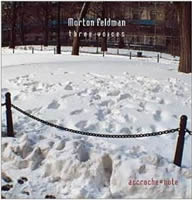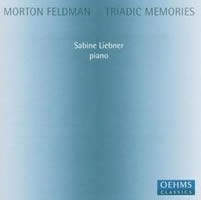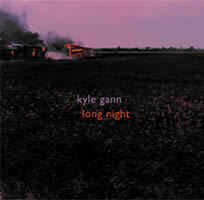Non-Trivial Simplicity
|
[I’ve taken my title from a New York Times music review by Bernard Holland in which he observes: “Simplicity is one thing, triviality another.”] Grant Chu Covell [August 2006.] Neophyte composers love their materials to death. Been there, done that: repeating the same damned progressions simply because the suspension pleased me, unaware that neighbors were arranging for my untimely demise. Seasoned composers develop their materials so that their beauty shines from any number of angles. But simple sounds will also do — so long as they’re well recorded.
Burkhard SCHLOTHAUER: abregistrieren (1998/2003). Eva-Maria Houben (organ). Edition Wandelweiser Records EWR 0501 (http://www.timescraper.de/_e-w-records/_ewr-catalogue/index.html). “ChamberEvents.” Burkhard SCHLOTHAUER: 55 similar sounds plus 2 drummers drumming (1998/99); events #5 (1994/95); organic microtonal polyphonia (2003). Edition Wandelweiser Records EWR 0502 (http://www.timescraper.de/_e-w-records/_ewr-catalogue/index.html). In abregistrieren, the “king of instruments” asphyxiates and expires in C. Of 50 minutes duration, a monster unison of multiple stops emerges and recedes. The organist leans on keys to produce bold sound, only to wiggle stops in order to alter and contrast the mixture. The ever-frugal Schlothauer also wants the listener to attend to the gaps among noises, quaverings and the odd beatings that occur when stops stall in unaccustomed positions. Enjoy abregistrieren at high volume to savor the thunder of an organ that sometimes sounds like a vacuum cleaner, a car rattling across a metal bridge, or a dishwasher’s rinse cycle. The stops cavort until, choked into submission, only the bellows’ breath remains. “ChamberEvents” reveals D.J. Burkhard’s remix. Schlothauer artfully rehashes older works including prior Edition Wandelweiser Records releases. Ably representing EWR’s roster, Schlothauer banishes all ornamentation, preferring to revel in naked tones. 55 similar sounds plus 2 drummers drumming layers an instrumental group (sax, trumpet, tuba, violin, cello, double-bass and accordion) over two percussionists. The instruments share one chord instrumented 55 different ways, repeating the event amidst pitch and color manipulations. As a distracting and inspired addition, the drums come and go, hammering out an unrelated pulse. Events #5 charts constellations from solitary piano and clarinet lines. Especially remarkable combinations arise in organic microtonal polyphonia, the fourth part of which layers three multi-tracked instruments (flute, clarinet and trombone) into billboard-sized tapestries. As always, EWR’s recording quality is unsurpassed: Wandelweiser’s quiet glows warm and buttery. When sounds do arrive, they are full-bodied, their details and contours laid bare. These newish releases abandon jewel boxes for stiff folded cardboard. Some have plastic nubs to hold their CDs in place.
Morton FELDMAN: Three Voices (1982). Ensemble Accroche Note: Françoise Kubler, Madeleine Koebelé, Laura Zimmermann (voices). l’empreinte digitale ED13189 (http://www.empreintedigitale-label.fr/). Distributed in the US by Forte Distribution (http://www.fortedistribution.com/). Morton FELDMAN: Triadic Memories (1981). Sabine Liebner (piano). Oehms Classics OC 510 (http://www.oehmsclassics.de/). Distributed in the US by Forte Distribution (http://www.fortedistribution.com/). Feldman wrote Three Voices for Joan La Barbara to perform against two pre-recorded copies of herself. The Ensemble Accroche Note uses three live singers. At 55:35, this strange rhapsody of whirring, rocking tones and gently nested patterns slows the pulse and heightens perception. When discernible words finally emerge, they arrive as a surprise. The trio’s timbres grate nasally, though I feel equally uneasy with La Barbara’s own New Albion NA018 recording. The composer called Triadic Memories “the largest butterfly in captivity.” Oehms splits this solo piano composition across two discs (67:41 + 56:28), creating a necessary albeit unsettling break. In Feldman’s unhurried land, changing details command our attention. The piano seems better suited to this aesthetic. Three Voices dwells upon the words “snow falls,” yet Triadic Memories better suggests an arctic blast’s bone-chilling immobility, cleansing and pure. Liebner plays calmly, sweeping the porch for the thousandth time. Her fragility is less perilous than that of Ensemble Accroche Note, which sounds to me collectively perturbed, as an uncharacteristic Feldman emotion. The composer didn’t supply a tempo for the a cappella piece, so it could be slower. Perhaps it suffers from having to fit on a single CD (La Barbara’s performance was 49:48). I’ve heard Ensemble Accroche Note before (Aperghis on Accord 201992, Dillon on Auvidis Montaigne MO 782037, Dusapin on Accord 461 788-2 and Radulescu on Auvidis Montaigne MO 782030) and trust their choices; however, I do wonder how a longer Three Voices might fare. Conversely, a cramped, single-disc traversal would surely cripple Triadic Memories.
“Awakening at the Inn of the Birds.” Michael BYRON: Continents of City and Love (2001); Tidal (1981); Evaporated Pleasure (2001); Awakening at the Inn of the Birds (2001); As She Sleeps (2000). Sarah Cahill, Joseph Kubera (pianos), Kathleen Supové (keyboards); FLUX Quartet; Gregg August (dbl. bass). Cold Blue Music CB0012 (http://www.coldbluemusic.com/). Kyle GANN: Long Night (1980-81). Sarah Cahill (piano). Cold Blue Music CD0019 (http://www.coldbluemusic.com/). Byron’s Evaporated Pleasure demands attention. Markedly different from its monolithic companions, this piano duo scrambles short gestures that appear to have been ripped from Conlon Nancarrow’s piano rolls. The Xenakis-like scale fragments with their unpredictable accents and silences don’t reflect the other pieces’ simplistic auras. Throughout its unyielding 13:11, Byron’s title piece, a fracas for string quartet, sounds like a startled flock giving flight. With slowly moving string chords and repeated piano tones, the reassuring Continents of City and Love spreads like a spilled soda, a sentimental recollection of better times. Tidal could be similarly described, with the rolling piano chords eventually overwhelming the tender string wash. The short As She Sleeps brings down the curtain with its calm repose. A long night indeed! Ubiquitous new-music pundit Gann’s early work for three pianos (or one pianist multi-tracked as here) strews undifferentiated material for just over 25 minutes. Gann’s self-review, smugly proffered to counter positive press, reveals the work’s structure. Frankly, I found the music more appealing after having skimmed Gann’s notes (larded with references to Heidegger and acknowledging the influence of Eno, Riley and Feldman). Within defined pitch ranges, each pianist meanders through repeating gestures, progressing together from one section to the next. Seemingly at odds with the work’s otherwise harmless demeanor, the tonality changes twice, creating a jarring dissonance. Contradicting critics who thought the transitions were flawed, the composer admits that these rifts warrant further exploration. Long Night is roomy enough for both perspectives, though I side with the piece’s creator. Gann’s preoccupations do intrigue, although the music’s New Age remnants tend to imperil the composer’s ideas. It would be unfair to compare Edition Wandelweiser Records’ sonics with the aptly named Cold Blue. While my mixing-board days are long behind me, I do know that some performances profit from heightened clarity, while others cannot.
[More Grant Chu Covell]
[Previous Article:
Setting Beer to Music]
[Next Article:
Lachenmann in Frankfurt and Elsewhere]
|
